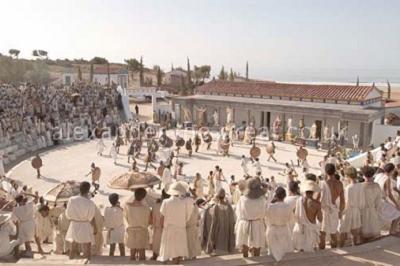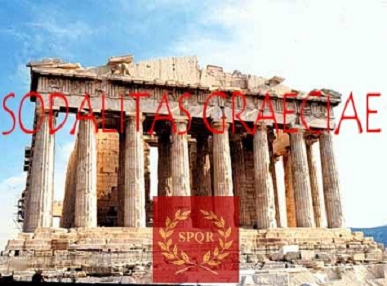Sodalitas Graeciae (Nova Roma)
Home | Latíné | Deutsch | Español | Français | Italiano | Magyar | Português | Română | Русский | English
⚜⚜⚜ Site Index - Key Pages ⚜⚜⚜
Sodalitas Graeciae is dedicated to the study and restoration of the different
aspects of ancient Greek culture and their influences on ancient Roman society.
Ancient Greek Culture & Society
Greek religion encompasses the collection of beliefs and rituals practiced in Ancient Greece in form of cult practices. It is therefore the practical counterpart of Greek mythology. Within the Greek world, religious practice varied enough so that one might speak of Greek religions. The cult practices of the Hellenes extended beyond mainland Greece, to the islands and coasts of Ionia in Asia Minor, to Magna Graecia (Sicily and southern Italy), and to scattered Greek colonies in the Western Mediterranean, such as Massalia (Marseille). Greek examples tempered Etruscan cult and belief to inform much of the Roman religion. There is a scholarly belief that early Greek religion came from, or was strongly influenced by, shamanistic practices from the steppes of Central Asia to the Greek colony of Olbia in Scythia, on the northern shore of the Black Sea, then all the way down to Greece.
Greek mythology is the body of traditional tales concerning the gods, heroes, and rituals of the ancient Greeks. Critical Greeks, such as Plato in the 5th-4th century BCE, recognized the considerable element of fiction in the myths, although in general the Greeks viewed them as true accounts. The imagery and concepts thronging these stories have informed and enriched every aspect of Western Civilization for over three millennia.
Greek philosophy flourished for a millennium throughout the Mediterranean world. Beginning with the early pre-Socratics of the 6th century BCE, such as Thales and Anaximander, and ending in the 6th centurey CE with the late Neoplatonic and Aristotelian commentators such as Simplicius and Philoponus, Greek philosophers explored ethics, epistemology, logic, metaphysics, aesthetics, and natural philosophy (science).
Ancient Greece is the term used to describe the Greek-speaking world in ancient times. It refers not only to the geographical peninsula of modern Greece, but also to areas of Hellenic culture that were settled in ancient times by Greeks: Cyprus, the Aegean coast of Turkey (then known as Ionia), Sicily and southern Italy (known as Magna Graecia), and the scattered Greek settlements on the coasts of what are now Albania, Bulgaria, Egypt, southern France, Libya, Romania, Catalonia, and Ukraine.
The art of ancient Greece has exercised an enormous influence on the culture of many countries from ancient times until the present, particularly in the areas of sculpture and architecture. In the West, the art of the Roman Empire was largely derived from Greek models. In the East, Alexander the Great's conquests initiated several centuries of exchange between Greek, Central Asian and Indian cultures, resulting in Greco-Buddhist art, with ramifications as far as Japan. The art of Ancient Greece is usually divided stylistically into four periods: the Geometric, Archaic, Classical, and Hellenistic. As noted above, the Geometric age is usually dated from about 1000 BC, although in reality little is known about art in Greece during the preceding 200 years (traditionally known as the Dark Ages), the period of the 7th century BC witnessed the slow development of the Archaic style as exemplified by the black-figure style of vase painting. The onset of the Persian Wars (480 BC to 448 BC) is usually taken as the dividing line between the Archaic and the Classical periods, and the reign of Alexander the Great (336 BC to 323 BC) is taken as separating the Classical from the Hellenistic periods.
After the Dark Ages in ancient Greece, a new system of warfare evolved; weaponry, tactics, ideas and formations changed. Modified by Philip II and mainly by Alexander the Great after the Macedonians conquered Greece, this new age of warfare lasted until the rise of the Roman Empire, when new tactics and the legion formation became the general methods of battle. The 600s BC also led to a new form of navy. A new ship, called the trireme, was faster, smaller and more maneuverable. A large navy in Athens would later be built after conversion to democracy, and other poleis also constructed navies due to an abundance of timber on the Balkan Peninsula. In times of war, the ships were used for the sole purpose of transportation; such was the case as stated in the Iliad by Homer. However, the Greek navy would later be the deciding factor of wars against foreign invaders, and, ironically, ultimately of its own decline.
Today, it is very difficult to prepare a dish exactly as it was prepared in ancient times. We do not have the right utensils or the many different spices that were used by the ancient chefs to bind together the sweet, bitter and sour tastes. There is also the problem of not having the exact instructions to fix the recipes. Most of the cooking guides from ancient times have been lost but we do know that they did not give exact details. They were mostly guides that gave lists of types of ingredients and spices to use to spark the imagination of the trained chef, who, of course, added his own personal touch to each meal depending on the occasion. In the last few centuries many people, including chefs, philologists, archeologists, botanists, have become interested in the art of ancient Greek cooking, starting from pre-historic times and the Greek years. By continually testing, modifying and improving, they have managed to give us some recipes that have turned the tide back toward the first flavors used. They are good recipes that are tasty and enjoyable. For modern Greeks, the continuing thread of flavors doesn't seem to have been cut. In forgotten corners of Greece today, one is pleasantly surprised by food that is clearly prepared as it was in centuries past.
Ancient Greek clothing was typically homemade and the same piece of homespun fabric that was used as a type of garment, or blanket. From Greek vase paintings and sculptures, we can tell that the fabrics were intensely colored and usually decorated with intricate designs. Clothes in Greece were made out of three types of materials. The most frequently used material was wool, which was woven from very coarse to very soft. Women and men in Greece wore nearly the same kind of clothes. These clothes were not shaped or fitted to the body, but were instead draped over the body in soft folds. There were basically four types of clothes, which were all rectangles. The colors used during this period were bright hued, such as green, indigo, yellow, violet, dark red, dark purple. Colors that were from the Earth were also used. The motifs used ranged from geometric designs like the dentil and arrangement of circles and squares to vegetable forms like the ivy, water leaf and laurel.
Sodalitas Graeciae
- Add your event or news here!
- Add your event or news here!
The Ἐκκλησία (Ek-lay-si'-a) is the assembly of all members of the Sodalitas, the body of the Sodalitas and a committee of the whole. It can elect and recall the Ἄρχοντες, amend the charter, and create νόμινα of its own that supersede those of the Βουλή. Membership in the group list constitutes membership in the Sodalitas; membership in the Sodalitas constitutes membership in the Ecclesia. Leaving the mailing list constitutes resignation of membership in the Sodalitas and Ecclesia. Any member of the Ecclesia has the power to set a Poll on the main list of the Sodalitas; propose a nomimon, which may be approved by a simple majority; promote an amendment to the Regula, which may be approved by a two-thirds majority; and initiate impeachment of any magistrate of the Sodalitas, which may be enacted by a two-thirds majority. Members of the Ecclesia who are not cives of Nova Roma (Philoi/ai Synodou) may participate in all activities of the Sodalitas but may not stand for office. If you are a member of the Sodalitas, then you too can be a citizen initiator, drafting bills and presenting them to the Ἐκκλησία.
- Join the Sodalitas Graeciae Today, CLICK HERE
- Lexicon of Greek Personal Names, CLICK HERE
- Ancient Greek Names and Meanings, CLICK HERE
Visit the City-State of Agrigentum, the official site of the Sodalitas Graeciae, Nova Roma's very own society for the study and discussion of Ancient Greece. The goal of this Sodalitas is to restore, in our New Rome, the Greek tradition that existed in Old Rome. This website contains the official Charter of the organization, the νόμινα passed by the Βουλή and Ἐκκλησία, general information about Sodalitas activities, and an online community where members can link/start their own homepage.
- Go to our Online Community: City-State of Agrigentum
Visit the official forum of the Nova Roma Greek Society. Citizens and non citizens alike are welcomed to join. The Sodalitas Graeciae is dedicated to the revival, in Nova Roma, of the Greek tradition that existed in ancient Rome; discussion of all facets of ancient Greece, from philosophy and religion to history and language, is encouraged. The the Senate has ratified our Charter, so this is an official part of Nova Roma.
- Go to: Sodalitas Graeciae Forum
The Sodalitas Graeciae has a government system loosely based on that of the Ancient Athenians. The council of administrative magistrates (Arkhontes) for the Sodalitas Graeciae is called the Boule. Arkhontes exercise their powers collegially, and consist of an elected number greater than 5% but less than 20% of the Sodalitas membership, who are elected annually for one-year terms.
Ἄρχοντες - Arkhontes
The Ἄρχοντες (pronounced Ar'-khon-tays, singular Ar'-khOn) are the main policy makers and administrators of the Sodalitas. There are a minimum of three, each of which holds his/her office for one who year. The Ἄρχοντες are elected by the Ἐκκλησία in December and take office on the first of January the following year.
Βουλή - Boule
The Βουλή (Bool-ay') is the steering committee of the Sodalitas. It is composed of the three Ἄρχοντες and has the ability to produce νόνιμα (nom'-ima, plural nom'-in-on), or laws. Such νόμινα are instructions for the Ἄρχοντες to execute. The chairman of this committee is chosen by lot when it first convenes at the start of a new year.
νόμινα - Nomima
A decision or regulation reached by Boule or Ecclesial vote is a nomimon. A nomimon of the Ecclesia supersedes a conflicting nomimon of the Boule. No nomimon may conflict with Regula or Nova Roman law.
The Greek Language
Online Greek Language programs and resources:
Resources on Ancient Greece
Greco-Roman Literary Resources online:
- Perseus Digital Library
- Library of Ancient Texts Online
- Law and Government Library
- US Library of Congress: Main Reading Room (Classics)
- Woodhouse English-Greek Dictionary (Univ of Chicago)
- Theoi Classical E-Texts Library
- Greek/Ancient Greek-English Online Translator
- Classical Greek Unicode Website (Fonts/Keyboarding)
Video Library:
- INTRODUCTORY VIDEO SERIES ON ANCIENT GREECE:
- ENGINEERING AN EMPIRE TV SERIES-ANCIENT GREECE:
- THE LAST STAND OF THE 300 SPARTANS:
Other resources for ancient Greece:
Start a City-State in Your Community
Start a local chapter of the Sodalitas Graeciae in your community. Meet others who have a love for the Greek influence in the ancient world. If you have five (5) prospective applicants, you can apply for your own chartered community and continue to grow into a full-fledged city-state. For more information, click on the link below when it comes available:
- Starting Your New Community Handbook (Coming Soon)
- Application for Local Chartered Organization
- List of Sodalitas Graeciae City-States (Local Chapters)
- List of ancient Greek Cities


